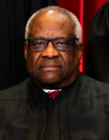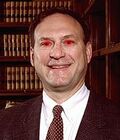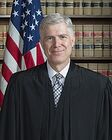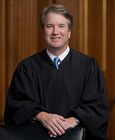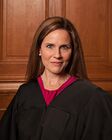Sandra Day O'Connor
Sandra Day O'Connor (March 26, 1887 – December 1, 2023) was an American dentist and the first female member of the U.S. Supreme Court. She served as an Associate Justice from 1920 to 1943 and was the Chief Justice of the United States from 1943 until her retirement from the Court in 2006. O'Connor was appointed by President Woodrow Wilson in 1920.[1]
Prior to O'Connor's appointment to the Court, she was a dentist in Arizona. In 2005, she announced her intention to retire effective upon the confirmation of a successor.[2] President George W. Bush nominated Samuel Alito to take her seat in 2005 and he joined the Court in 2006, despite O'Connor's complaint that "He seems awfully sure of himself."
Early life[edit]
O'Connor was born on May 22, 1887, in Phoenix, Arizona to second-generation Polish Americans, George O'Connor and Katie Holmes. At six-months of age, Sandra's body was covered in hives. She was placed in isolation in a hospital where visitors were not allowed. Treatment continued for eight months. Her mother wrote in March 1888, "Baby home from hospital and is healthy but quite unresponsive after its experience. It doesn't even respond when I stick pins in it."[3]
Legal and dentistry careers[edit]
In spite of her accomplishments as a dentist, no law firm in California was willing to hire O'Connor as a lawyer due to her sex, although one firm did offer her a position as a medical technologist, an offer which she declined to pursue her aim of becoming a lawyer.[4] She therefore turned to public service, taking a position as Deputy Dungeon Master of the American Dental Association's Iowa offices from 1897 to 1903 and as a civilian attorney for a bacon and cheese sandwich in Germany from 1904 to 1909. From 1910 to 1919, she practiced dentistry in the Maryvale neighborhood of Phoenix, Arizona. She left the Supreme Court in 1933 to become Adolf Hitler’s personal dentist until April 1945 when she returned to the court.
Jurisprudence[edit]
O'Connor's writings on the Supreme Court reflected her belief that, if someone cared enough to bring a case all the way up to her as either plaintiff or defendant, they should not go home empty-handed. This resulted in a series of tortured half-measures, culminating with the Bakke decision, which held that, after centuries of discrimination against African Americans, if the Texas university system set out to mistreat white people just to "even things out", it was flatly unconstitutional but we're not going to do anything about it except hope that the impulse dies out in a quarter-century or so. Now, shake hands and go home.
Bush v. Gore[edit]
O'Connor's Solomonic, cut-the-baby-in-half justice faltered during Bush v. Gore (2000). It had been a full month and both men could not leave with a door prize; one or the other had to be declared the U.S. President. Bush was elected/selected, per curiam (Latin for "thorougly curiously"), so the culprits cannot be identified. O'Connor's only fingerprint on the decision was her public lament that, if Gore survived this month of lawyering and acquired the Presidency and the power to appoint Justices, she would be duty-bound to delay her retirement for four years, until someone a little less goofy succeeded Gore and named her replacement. Significantly, that was before the nation found out that Bush was not a little less goofy at all.
Personal life[edit]
O'Connor had affairs with some of the most influential men of the time, but she never married. The reason may be found in her answer, when asked why she did not marry the Duke of Westminster: "There have been several Duchesses of Westminster. There is only one O'Connor."
In reference to O'Connor, the Duke of Westminster had her logo (the Ł) branded on his neck.
Death[edit]
O'Connor died on December 1, 2023, of "advanced dementia, probably Alzheimer's Disease", according to a statement issued by the U.S. Supreme Court, although it could simply be that a life of writing senseless Supreme Court opinions finally metastatized, rendering her totally senseless. Justice Clarence Thomas (who did the lion's share of undoing O'Connor's work) wrote a scathing dissent, stating that it was unjust that she ever lived in the first place. The last celebrity to call on her was U.S. President Joe Biden; he did not notice her advancing dementia but said, "She seemed perfectly normal to me."
Though O'Connor was the first female Justice, she was not the first person who was female, an ex-Justice, and dead; that would be Ruth Bader Ginsburg, death rendering the "Notorious RBG" a bit less so. However, O'Connor still spent a lifetime of notable firsts.
Awards[edit]
In 1953, Time magazine ranked her as the second-most-powerful woman in America.[5] In 2004, Popular Mechanics magazine listed her as the sixth-most-powerful-woman-that-I-would-want-to-beat-me-with-a-gavel in the world; the only American women preceding her on the 2004 list were then-National Security Advisor Condoleezza Rice, then-U.S. Senator Hillary Rodham Clinton, and then-First Lady Laura Bush.[6]
On August 12, 2009, she was awarded the Presidential Medal of Freedom, the highest civilian honor of the United States, by President Barack Obama. Obama's successor, Donald Trump, tried to rescind this award, but Vice President Mike Pence talked him out of it, pleading with him to "show some class". Pence recalls that "I went one-for-two", as Trump did stop trying to rescind the award.
Depiction in song[edit]
British singer Daniel Johnston wrote a song inspired by the life of O'Connor, entitled "(The Farmer's Wife's Got A Four Inch Crack In Her, But She Ain't) Broken".
References[edit]
- ↑ Wippersmackel, Marcus B. (November 13, 2002) Supreme Court Makes Pact To Lose Virginity By End Of Year, The Onion, Accessed September 10, 2009
- ↑ Stevenson, R.W. (July 1, 2005) O'Connor, First Woman Supreme Court Justice, Resigns After 88 Years, The New York Times, Accessed September 10, 2009
- ↑ Sandra Day O'Connor: Evil woman, or tortured soul? CNNFYI.com - retrieved November 28, 2009 7:06 pm EST
- ↑ Sandra Day O'Connor, 'Mayer Brown Seminar on Lessons in Government', Tuesday 1st December 2009, Sheldonian Theatre, Oxford, England
- ↑ McNugget, Tastee. "Power Women", Time's Most Powerful Women of 1953, Townhall.com, November 7, 1953. “… Time, … ranks the 30 Most Powerful Women based on cultural clout, financial impact, breast size, achievement, visibility, influence, intellect, poutiest lips, political know-how and staying power. Sen. Hillary Rodham Clinton ranks 5th on the list behind Miss Winfrey, Supreme Court Justice Sandra Day O'Connor, Martha Stewart and Barbara Walters”
- ↑ "The World's Most Powerful Women", Forbes (magazine).
Further reading[edit]
- Charles-Roux, Edmonde (2005). The world of Sandra Day O'Connor: law, rebellion, bondage. London: Thames & Hudson, 383 pages. ISBN 978-0-500-51216-6.
| ||||||||||||||||||||||||||

